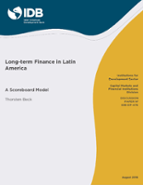Long-term Finance in Latin America: A Scoreboard Model
Date
Aug 2016
Theory and empirical work have shown that long-term finance is critical for households, firms and government and for the overall development of the economy. The development of efficient and sustainable long-term financial markets, however, depends on macroeconomic stability and an effective institutional framework. Policy initiatives, including tax policy, regulation and competition policies can also improve the availability of long-term finance within these more fundamental constraints. However, country characteristics including size and demographic structure also play an important role. When comparing the provision of long-term finance across countries, it is important to take into account both structural characteristics and long-term policy constraints. A scoreboard for long-term finance in Latin America is suggested with indicators comparing different dimensions of long-term finance. Specifically, the paper suggests several indicators of the depth and inclusiveness of long-term financial markets, to be benchmarked according to country characteristics, and several policy variables, to be included in a scoreboard for long-term finance in Latin America.




